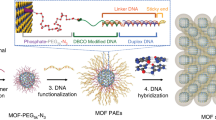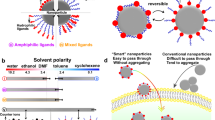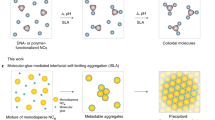Abstract
Various properties of semiconductor nanoparticles, including photoluminescence and catalytic activity, make these materials attractive for a range of applications1,2. As nanoparticles readily coagulate and so lose their size-dependent properties, shape-persistent three-dimensional stabilizers that enfold nanoparticles have been exploited3,4,5,6,7,8,9. However, such wrapping approaches also make the nanoparticles insensitive to external stimuli, and so may limit their application. The chaperonin proteins GroEL (from Escherichia coli) and T.th (‘T.th cpn’, from Thermus thermophilus HB8) encapsulate denatured proteins inside a cylindrical cavity; after refolding, the encapsulated proteins are released by the action of ATP inducing a conformational change of the cavity10,11. Here we report that GroEL and T.th cpn can also enfold CdS semiconductor nanoparticles, giving them high thermal and chemical stability in aqueous media. Analogous to the biological function of the chaperonins, the nanoparticles can be readily released from the protein cavities by the action of ATP. We expect that integration of such biological mechanisms into materials science will open a door to conceptually new bioresponsive devices.
This is a preview of subscription content, access via your institution
Access options
Subscribe to this journal
Receive 51 print issues and online access
$199.00 per year
only $3.90 per issue
Buy this article
- Purchase on Springer Link
- Instant access to full article PDF
Prices may be subject to local taxes which are calculated during checkout





Similar content being viewed by others
References
Alivisatos, A. P. Semiconductor clusters, nanocrystals, and quantum dots. Science 271, 933–937 (1996)
Schmid, G. et al. Current and future applications of nanoclusters. Chem. Soc. Rev. 28, 179–185 (1999)
Meldrum, F. C., Heywood, B. R. & Mann, S. Magnetoferritin — in vitro synthesis of a novel magnetic protein. Science 257, 522–523 (1992)
Wong, K. K. W. & Mann, S. Biomimetic synthesis of cadmium sulfide-ferritin nanocomposites. Adv. Mater. 8, 928–932 (1996)
Shenton, W., Pum, D., Sleytr, U. B. & Mann, S. Biocrystal templating of CdS superlattices using self-assembled bacterial S-layers. Nature 389, 585–587 (1997)
Balogh, L. & Tomalia, D. A. Poly(amidoamine) dendrimer-templated nanocomposites. 1. Synthesis of zerovalent copper nanoclusters. J. Am. Chem. Soc. 120, 7355–7356 (1998)
Lemon, B. I. & Crooks, R. M. Preparation and characterization of dendrimer-encapsulated CdS semiconductor quantum dots. J. Am. Chem. Soc. 122, 12886–12887 (2000)
Shenton, W., Mann, S., Cölfen, H., Bacher, A. & Fischer, M. Synthesis of nanophase iron oxide in lumazine synthase capsids. Angew. Chem. Int. Edn Engl. 40, 442–445 (2001)
McMillan, R. A. et al. Ordered nanoparticle arrays formed on engineered chaperonin protein templates. Nature Mater. 1, 247–252 (2002)
Roseman, A. M., Chen, S., White, H., Braig, K. & Saibil, H. R. The chaperonin ATPase cycle: mechanism of allosteric switching and movements of substrate-binding domains in groEL. Cell 87, 241–251 (1996)
Ranson, N. A. et al. ATP-bound states of groEL captured by cryo-electron microscopy. Cell 107, 869–879 (2001)
Hendrix, R. W. Purification and properties of groE, a host protein involved in bacteriophage assembly. J. Mol. Biol. 129, 375–392 (1979)
Braig, K. et al. The crystal structure of the bacterial chaperonin groEL at 2.8 Å. Nature 371, 578–586 (1994)
Taguchi, H., Konishi, J., Ishii, N. & Yoshida, M. A chaperonin from a thermophilic bacterium, Thermus thermophilus, that controls refoldings of several thermophilic enzymes. J. Biol. Chem. 266, 22411–22418 (1991)
Amada, K. et al. Molecular cloning, expression, and characterization of chaperonin-60 and chaperonin-10 from a thermophilic bacterium, Thermus thermophilus HB8. J. Biochem. 118, 347–354 (1995)
Ishii, N., Taguchi, H., Sumi, M. & Yoshida, M. Structure of holo-chaperonin studied with electron microscopy. Oligomeric cpn10 on top of two layers of cpn60 rings with two stripes each. FEBS Lett. 299, 169–174 (1992)
Ishii, N., Taguchi, H., Sasabe, H. & Yoshida, M. Folding intermediate binds to the bottom of bullet-shaped holo-chaperonin and is readily accessible to antibody. J. Mol. Biol. 236, 691–696 (1994)
Murakoshi, K. et al. Preparation of size-controlled hexagonal CdS nanocrystallites and the characteristics of their surface structures. J. Chem. Soc. Faraday Trans. 94, 579–586 (1998)
Hosokawa, H. et al. In-situ EXAFS observation of the surface structure of colloidal CdS nanocrystallites in N,N-dimethylformamide. J. Phys. Chem. 100, 6649–6656 (1996)
Brus, L. E. Electron-electron and electron-hole interactions in small semiconductor crystallites: The size dependence of the lowest excited electronic state. J. Chem. Phys. 80, 4403–4409 (1984)
Ramsden, J. J. & Grätzel, M. Photoluminescence of small cadmium sulfide particles. J. Chem. Soc. Faraday Trans. 1 80, 919–933 (1984)
Hengleln, A. Photochemistry of colloidal cadmium sulfide. 2. Effects of adsorbed methyl viologen and of colloidal platinum. J. Phys. Chem. 86, 2291–2293 (1982)
Llorca, O., Galán, A., Carrascosa, J. L., Muga, A. & Valpuesta, J. M. GroEL under heat-shock. J. Biol. Chem. 273, 32587–32594 (1998)
Martin, J., Horwich, A. L. & Hartl, F. U. Prevention of protein denaturation under heat stress by the chaperonin Hsp60. Science 258, 995–998 (1992)
Goloubinoff, P., Christeller, J. T., Gatenby, A. A. & Lorimer, G. H. Reconstitution of active dimeric ribulose bisphosphate carboxylase from an unfolded state depends on two chaperonin proteins and Mg-ATP. Nature 342, 884–889 (1989)
Todd, M. J., Viitanen, P. V. & Lorimer, G. H. Hydrolysis of adenosine 5′-triphosphate by Escherichia coli groEL: effects of groES and potassium ion. Biochemistry 32, 8560–8567 (1993)
Acknowledgements
We thank K. Konishi for his initial contribution to the present work; K. Tsumoto for discussions; J. Oono and M. Nakamura for SEC analysis with MALS. N.I. was responsible for TEM microscopy. We acknowledge support from the 21st Century COE Programs of Research and Education (T.A., Human–Friendly Materials Based on Chemistry; M.Y., Future Nano-Materials), and from the JST ERATO Nanospace program. K.K. acknowledges support from the Nissan Science Foundation.
Author information
Authors and Affiliations
Corresponding author
Ethics declarations
Competing interests
The authors declare that they have no competing financial interests.
Supplementary information
Rights and permissions
About this article
Cite this article
Ishii, D., Kinbara, K., Ishida, Y. et al. Chaperonin-mediated stabilization and ATP-triggered release of semiconductor nanoparticles. Nature 423, 628–632 (2003). https://doi.org/10.1038/nature01663
Received:
Accepted:
Issue Date:
DOI: https://doi.org/10.1038/nature01663
This article is cited by
-
Protein-caged zinc porphyrin as a carbonic anhydrase mimic for carbon dioxide capture
Scientific Reports (2020)
-
Tolerance analysis of photonic crystal substrate used in spectrometer-free photonic crystal enhanced microscopy
Optical and Quantum Electronics (2020)
-
Observation of gold sub-nanocluster nucleation within a crystalline protein cage
Nature Communications (2017)
-
Collective helicity switching of a DNA–coat assembly
Nature Nanotechnology (2017)
Comments
By submitting a comment you agree to abide by our Terms and Community Guidelines. If you find something abusive or that does not comply with our terms or guidelines please flag it as inappropriate.



